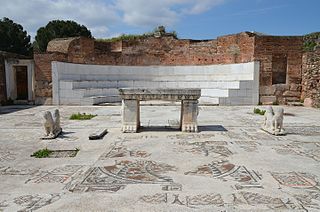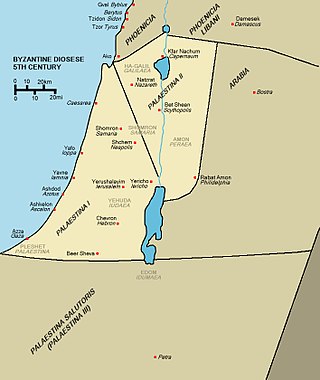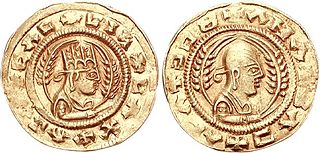Related Research Articles

Obadiah, also known as Abdias, is a biblical prophet. The authorship of the Book of Obadiah is traditionally attributed to the prophet Obadiah.

The Himyarite Kingdom was a polity in the southern highlands of Yemen, as well as the name of the region which it claimed. Until 110 BCE, it was integrated into the Qatabanian kingdom, afterwards being recognized as an independent kingdom. According to classical sources, their capital was the ancient city of Zafar, relatively near the modern-day city of Sana'a. Himyarite power eventually shifted to Sana'a as the population increased in the fifth century. After the establishment of their kingdom, it was ruled by kings from dhū-Raydān tribe. The kingdom was named Raydān.

Adiabene was an ancient kingdom in northern Mesopotamia, corresponding to the northwestern part of ancient Assyria. The size of the kingdom varied over time; initially encompassing an area between the Zab Rivers, it eventually gained control of Nineveh and starting at least with the rule of Monobazos I, Gordyene became an Adiabenian dependency. It reached its zenith under Izates II, who was granted the district of Nisibis by the Parthian king Artabanus II as a reward for helping him regain his throne. Adiabene's eastern borders stopped at the Zagros Mountains, adjacent to the region of Media. Arbela served as the capital of Adiabene.
Dhū Nuwās,, real name Yūsuf Asʾar Yathʾar, Yosef Nu'as, or Yūsuf ibn Sharhabil, also known as Masruq in Syriac, and Dounaas (Δουναας) in Medieval Greek, was a Jewish king of Himyar reigning between 522–530 AD who came to renown on account of his persecutions of peoples of other religions, notably Christians, living in his kingdom. He was also known as Zur'ah ibn Tub'an As'ad Abi Karib in the Arab traditions.

Rabbinic Judaism, also called Rabbinism, Rabbinicism, or Rabbanite Judaism, has been the mainstream form of Judaism since the 6th century CE, after the codification of the Babylonian Talmud. Rabbinic Judaism has its roots in the Pharisaic school of Second Temple Judaism, and is based on the belief that Moses at Mount Sinai received both the Written Torah and the Oral Torah from God. The Oral Torah, transmitted orally, explains the Written Torah. At first, it was forbidden to write down the Oral Torah, but after the destruction of the Second Temple, it was decided to write it down in the form of the Talmud and other rabbinic texts for the sake of preservation.

Najran, is a city in southwestern Saudi Arabia It is the capital of Najran Province. Designated as a new town, Najran is one of the fastest-growing cities in the kingdom; its population has risen from 47,500 in 1974 and 90,983 in 1992 to 246,880 in 2004 and 381,431 in 2021. The population mostly originates from the ancient tribes of Yām,

The Banu al-Harith is an Arabian tribe which once governed the cities of Najran, Taif, and Bisha, now located in southern Saudi Arabia.

The ancient history ofYemen or South Arabia is especially important because it is one of the oldest centers of civilization in the Near East. Its relatively fertile land and adequate rainfall in a moister climate helped sustain a stable population, a feature recognized by the ancient Greek geographer Ptolemy, who described Yemen as Eudaimon Arabia meaning Fortunate Arabia or Happy Arabia. Between the eighth century BCE and the sixth century CE, it was dominated by six main states which rivaled each other, or were allied with each other and controlled the lucrative spice trade: Saba', Ma'īn, Qatabān, Hadhramaut, Kingdom of Awsan, and the Himyarite Kingdom. Islam arrived in 630 CE and Yemen became part of the Muslim realm.
Monobazus II was the son of Queen Helena of Adiabene and King Monobazus I. He is known as Monobaz in the Babylonian Talmud.
Ananias of Adiabene was a Jewish merchant and mendicant proselytizer, probably of Hellenistic origin, who, in the opening years of the common era, was prominent at the court of Abinergaos I (Abennerig), king of Characene. He was instrumental in the conversion to Judaism of numerous native and foreign inhabitants of Charax Spasinu. This city, the capital of Characene, was situated at the confluence of the two arms of the Tigris near the Persian Gulf and was at the time a great mercantile center.
It is believed that Jews began immigrating to the Arabian Peninsula in as early as the 6th century BCE, when the Babylonian conquest of Judah triggered a mass Jewish exodus from Judea in the Land of Israel. Over time and through successive exiles, the local Jewish tribes, who were concentrated in the Hejaz and partly in South Arabia, established themselves as one of the most prominent ethno-religious communities of pre-Islamic Arabia. Likewise, Judaism, which had been introduced as one of the few monotheistic religions in the region, stood as a deviation from the typical polytheistic practices of Arabian paganism. These Jewish tribes continued to have a presence in Arabia during the rise of Muhammad, who founded Islam in the 7th century CE. Muhammad's interaction with the Jewish community is documented to a considerable degree in Islamic literature, including in many ahadith. The Jewish tribes of the Hejaz are seen in Islam as having been the offspring of the Israelites/Hebrews Two of Muhammad's wives were Jewish: Safiyya bint Huyayy and Rayhanah bint Zayd, both of whom belonged to the Banu Nadir by birth, though Rayhanah's status as a wife instead of a concubine is disputed.
Abū Karib As’ad al-Kāmil,, called "Abū Karīb", sometimes rendered as As'ad Abu Kurayb, full name: Abu Karib As'ad ibn Hassān Maliki Karib Yuha'min, was king of the Himyarite Kingdom. He ruled Yemen from 390 CE until 420 CE, beginning as a coregency with his father Malkikarib Yuhamin followed by becoming sole ruler in 400. As'ad is cited in some sources as the first of several kings of the Arabian Peninsula to convert to Judaism, although contemporary historians have ascribed this transition to his father. He was traditionally regarded as the first one to cover the Kaaba with the kiswah.

God-fearers or God-worshippers were a numerous class of Gentile sympathizers to Hellenistic Judaism that existed in the Greco-Roman world, which observed certain Jewish religious rites and traditions without becoming full converts to Judaism. The concept has precedents in the proselytes of the Hebrew Bible.

Palaestina Secunda or Palaestina II was a province of the Byzantine Empire from 390, until its conquest by the Muslim armies in 634–636. Palaestina Secunda, a part of the Diocese of the East, roughly comprised the Galilee, Yizrael Valley, Bet Shean Valley and southern part of the Golan plateau, with its capital in Scythopolis. The province experienced the rise of Christianity under the Byzantines, but was also a thriving center of Judaism, after the Jews had been driven out of Judea by the Romans in the 1st and 2nd centuries.

The Kingdom of Aksum also known as the Kingdom of Axum, or the Aksumite Empire, was a kingdom in East Africa and South Arabia from classical antiquity to the Middle Ages. Based in what is now northern Ethiopia and Eritrea, and spanning present-day Djibouti and Sudan, it extended at its height into much of South Arabia during the reign of Kaleb of Axum. Aksumite under Kaleb invaded Southern Arabia and Yemen from 520 and controlled it until 525 when Sumyafa Ashwa was deposed by Abraha.
The existence of a Christian community in the city of Najran in present-day southwestern Saudi Arabia is attested by several historical sources of the Arabian Peninsula, where it recorded as having been created in the 5th century AD or perhaps a century earlier. According to the Arab Muslim historian Ibn Ishaq, Najran was the first place where Christianity took root in South Arabia.

The Al-Qalis Church was a Miaphysite Christian church constructed sometime between 527 and the late 560s in the city of Sanaa in modern-day Yemen. The church's lavish decorations made it an important place of pilgrimage, placing it in competition with Kaaba in Mecca. According to the National Museum of Saudi Arabia in Riyadh, Abraha built Al-Qullays in Sana'a. He also built a similar one in Najran for Bani Al-Harith, the House of Allat in Taif for the tribe of Thaqeef, the House of Yareem and the House of Ghamdan in Yemen.

The Aksumite invasion of Himyar consisted of a series of two invasions from 518 to 525 fought between the Christian Kingdom of Aksum and the Jewish Himyarite Kingdom. The wars functioned as proxy wars waged by the former on behalf of the Roman Empire during the Roman-Persian Wars with the ultimate goal of establishing an anti-Sasanid bloc in Arabia Felix.
References
- ↑ Jewish Encyclopedia "He was by birth a Gentile from Pontus, and is said by Epiphanius to have been a connection by marriage of the emperor Hadrian and to have been appointed by him about the year 128 to an office concerned with the rebuilding of Jerusalem as "Ælia Capitolina." At some unknown age he joined the Christians, but afterward left them and became a proselyte to Judaism."
- ↑ Fordham University
- ↑ "USA Religious News". www.usareligiousnews.com. Archived from the original on 8 October 2007. Retrieved 12 January 2022.
- ↑ Jewish Encyclopedia
- ↑ Jewish Encyclopedia "If the contradictory and sometimes legendary accounts of the personality of Dhu Nuwas given by the Arabian writers can be trusted, he was not a Jew by birth, but embraced Judaism after ascending the throne, taking the name of "Joseph."
- ↑ Jewish Encyclopedia "Obadiah was a proselyte of Edomite origin."
- ↑ Jewish Encyclopedia
- ↑ Jewish Encyclopedia
- ↑ Jewish Encyclopedia
- ↑ BBC